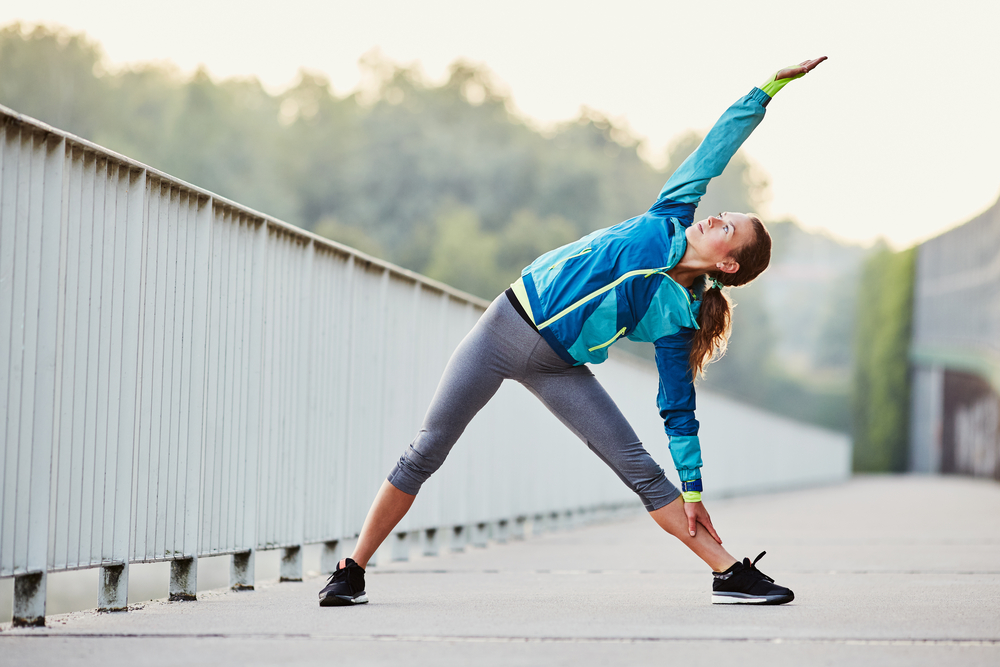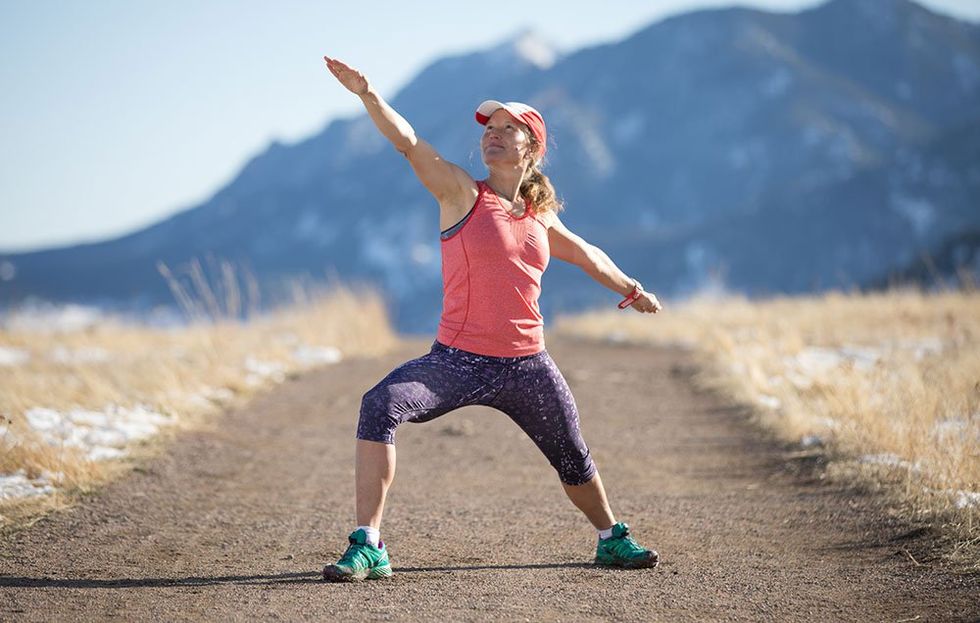Yoga for Runners

In today's fitness-conscious society, running stands as a testament to endurance, determination, and agility. Yet, with the rhythmic cadence of each stride comes the need for balance, both in physical form and mental fortitude. This is where yoga, with its ancient roots and comprehensive approach to well-being, steps onto the track. Yoga's unique blend of stretches, strength-building poses, and mindful breathing offers runners a cross-training option that not only enhances performance but also fosters injury prevention and recovery. Today, Everyday Yoga will show you how the integration of yoga into a runner's regimen is transforming modern athletic practices, helping runners achieve new personal bests not only on the road but in their overall health and vitality.
The Synergy between Running and Yoga
Running often requires repetitive linear movements that can lead to muscle imbalances and tightness, particularly in the legs, hips, and lower back. Yoga complements running by addressing these imbalances through its multidirectional and varied poses, promoting flexibility and strength in underutilized muscles. Moreover, yoga's breathwork and meditation components train the mind for the endurance and focus that benefit long-distance runners.
Why Runners Should do Yoga?
Runners can draw from the rich well of yoga to find multiple benefits for their practice.
Enhanced Flexibility
Regular yoga practice increases range of motion, aiding in smoother and more efficient running strides. Lengthening your muscles by stretching stimulates greater flexibility; there's no question about that. It also reduces tension in your tendons and ligaments, encouraging the free flow of lubricating fluids. Holding poses for a long time, while breathing deeply, sends freshly oxygenated blood to your muscles and ligaments. This speeds up the healing process, repairs damage, and reduces inflammation.
Improved Core Strength
Strong core muscles maintain running form, leading to better performance and reduced injury risk.
Balance and Stability
Balancing poses in yoga develop proprioception and stability, important for runners navigating uneven terrain.
Injury Prevention
By alleviating tightness and strengthening the supporting muscles, yoga can help prevent common running injuries.
Mental Stamina
The meditative aspect of yoga aids in cultivating focus and mental resilience, essential for endurance running.
Recovery Aid
Gentle yoga practices can serve as an effective recovery tool, aiding in muscle repair and relaxation post-run.

Yoga Poses for Runners
Begin incorporating the following poses into your warm-up and cool-down. Hold each pose for several breaths, but come out of any if you feel pinching or jarring pain. Move slowly in and out of each pose. Keep your breath smooth and even. If you're struggling to breathe, ease up a bit. Always work within your own range of limits and abilities.
Full Body Stretch: Downward-Facing Dog

One of the most-recognized yoga poses in the West, Downward-Facing Dog – Adho Mukha Svanasana (Ah-doh MOO-kuh shvan-AHS-uh-nuh) — energizes and rejuvenates the entire body. Do not practice if you have severe carpal tunnel syndrome or are in late-term pregnancy.
- Begin in Table Pose, on your hands and knees. The fold of your wrists should be parallel with the top edge of your mat; your middle fingers should point directly to the top edge of your mat. With your feet hip-distance apart, exhale and lift your knees off the floor. Gently begin to straighten your legs, but do not lock your knees. As you lengthen your spine, lift your sit bones up toward the ceiling. Press down equally through your heels and the palms of your hands.
- Firm the outer muscles of your arms and press your index fingers into the floor. Lift from the inner muscles of your arms to the top of your shoulders. Draw your shoulder blades into your upper back ribs and down towards your tailbone. Relax your head between your upper arms, but do not let it dangle.
- Hold for 5-100 breaths. Gently bend your knees with an exhalation and come back into Table Pose to release.
Balance: Tree Pose

A popular balancing pose, Tree Pose — Vrksasana (vrik-SHAH-suh-nuh) — also stretches the thighs, torso, and shoulders. It builds strength in the ankles and calves, and helps to remedy flat feet.
- Begin standing with your arms at your sides and your feet hip-distance apart. Slightly shift your weight to your left foot. Bend your right knee, reach down and clasp your right ankle.
- Use your hand to draw your right foot alongside your inner left thigh. Do not rest your foot against your knee, only above or below it.
- Rest your hands on your hips and lengthen your tailbone toward the floor. Fix your gaze softly in front of you. Press your right foot into your left thigh.
- For a deeper pose, extend your arms above your head, reaching your fingertips towards the sky. To deepen your pose, try closing your eyes.
- Hold for up to one minute. Step back into the starting position, and then repeat on the opposite side.
Hip Opener: One-Legged King Pigeon Pose

Usually just called Pigeon Pose – Eka Pada Rajakapotasana (EKK-uh PAHD-uh RAH-juh-KA-poh-TAHS-uh-nuh — this is a powerful hip opener. It relieves tension in the chest and shoulders and stimulates the abdominal organs. Do not practice if you have a knee or ankle injury.
- Begin in Downward-Facing Dog, or on your hands and knees in Table Pose.
- Bring your right knee between your hands, placing your right ankle near your left wrist. Extend your left leg behind you, with your kneecap and the top of your foot on the floor.
- Press through your fingertips as lift your torso away from your thigh, lengthening the front of your body. Release your tailbone back toward your heels.
- Exhaling, fold your upper body forward over your right shin. Draw down through the front shin and balance your weight evenly between your right and left hips.
- Hold for up to one minute. To release, press through your hands to gently lift your torso off the mat, tuck your back toes, and lift into Downward-Facing Dog. Repeat on the other side.
Place a folded blanket or yoga block under the hip of your front leg for extra support!
Hamstring Stretch: Supine Hand to Big Toe Pose

Supine Hand to Big Toe Pose (also called Reclining Big Toe Pose) – Supta Padangusthasana (SOOP-tuh PAHD-ahn-goos-TAHS-uh-nuh) — is a gentle hamstring stretch that helps open the hips and reduce low back pain. It requires a yoga strap, but a towel or belt will also work.
- Lie on your back. Bend your right knee and hug your thigh into your chest. Keep your left leg extended along the floor. Wrap the strap around the ball of your right foot and grasp it with both hands.
- Straighten your knee, extending your heel to the ceiling. Keep your right foot flexed and your buttocks equally balanced on the floor. As you draw slightly down on the strap, let the head of your thigh bone rest in your hip socket. Feel your lower back press into the ground.
- Hold for 5-10 breaths.
- Place the strap in your right hand and turn your leg outward to the right. Keeping your left thigh pressing down, lower your right leg all the way to the right. Let your toes hover a few inches above the mat, keeping your leg outwardly rotated.
- Hold for 5-10 breaths.
- Inhale as you raise your leg again. Exhale as you draw your knee into your chest and let go of the strap, and then release your leg completely.
- Repeat on the opposite side.
Recovery: Legs Up the Wall

Ancient yoga texts claim that Legs Up the Wall — Viparita Karani (VIP-uh-REE-tuh kah-RAH-nee) — will destroy old age. Many modern teachers agree to its benefits, including relief from anxiety, headaches, insomnia, mild depression, and much more. It stretches the back of the legs, calms the mind, and relieves fatigue and cramping in the legs and feet.
- Set a bolster or pillow on the floor against the wall.
- Sit sideways against the wall with your lower back against the bolster.
- Gently bring your legs up onto the wall. Use your hands for balance as you shift your weight as you lie down.
- Rest your shoulders and head on the floor. Your lower back should now be fully supported by the bolster.
- Hold for 5-10 minutes, breathing with awareness.
- To release, slowly push yourself away from the wall and slide your legs to the side.
Flex for Fun
Yoga can be a fun way for runners to remember the joy of movement. The alignment, flexibility, and strength gained in yoga can power up your runs. Yogic breathing and mind-calming techniques can turn your simple jog or 20-mile run into a moving meditation.
For the modern runner, yoga is not just cross-training; it's a necessary discipline that elevates the act of running into a sustainable form of exercise. The interplay of these practices equips runners with not only stronger bodies but also a sharper focus that can push them across finish lines, both literal and metaphorical. With Everyday Yoga, let's lace up your shoes, unroll your mat, and find the perfect balance of movement and stillness in your training.
Whether you've experienced the benefits of yoga in your own running journey or are considering adding it to your training, we invite you to share your insights and stories. Let this be a space where the collective wisdom of the running community can flourish as we support one another on the path to peak performance.
See you on the mat!
Namaste!

